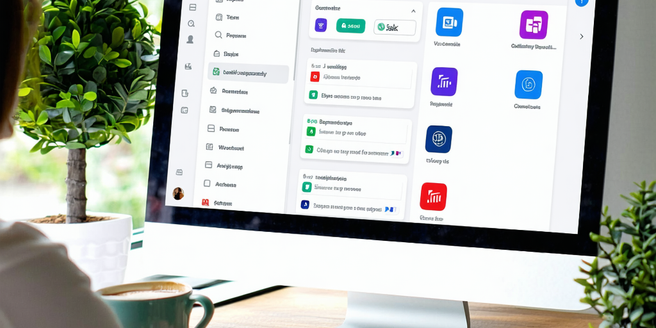
Embracing Digital Tools for Creative Collaboration
In today’s remote working environment, leveraging digital tools can dramatically enhance creative collaboration. Platforms like Slack, Trello, and Zoom have become staples for communication and project management. These tools provide virtual spaces where team members can brainstorm, share insights, and develop ideas in real-time, mimicking the immediacy and spontaneity of in-person collaboration. Additionally, innovative software such as Miro provides digital whiteboards for sketching out ideas collectively, while Google Workspace allows for simultaneous document editing, ensuring everyone can contribute equally. By integrating these digital resources, remote teams can overcome geographical boundaries, fostering a more inclusive and dynamic creative process. Adapting to these tools can be initially challenging, but with consistent use, they become invaluable assets that encourage creativity and build a more connected remote team.
Virtual Brainstorming: Techniques That Work
The shift to remote work has necessitated new approaches to brainstorming. Virtual brainstorming, when done effectively, can facilitate the exchange of creative ideas across distances. Utilizing breakout rooms within video conferencing apps allows smaller groups to engage deeply, fostering diverse perspectives. Techniques such as mind mapping are invaluable, enabling participants to visualize connections between ideas collectively. Additionally, the use of asynchronous brainstorming can benefit teams working in different time zones, allowing individuals to contribute thoughts over a defined period. Tools like digital sticky notes and shared documents ensure ideas are captured and refined. These strategies maintain momentum and ensure productive sessions. By adopting flexible and inclusive virtual brainstorming methods, remote teams can harness creativity to achieve innovative outcomes.
Building a Creative Remote Team Culture
Cultivating a creative culture in a remote team requires intentional action. Establishing a supportive environment where team members feel valued and respected is paramount. Regular virtual meetings and check-ins foster communication and collaboration, which are vital for creativity. Encouraging free-flowing ideas without immediate critique can drive innovation, as individuals are more likely to voice their thoughts when they are assured of a safe space. Leaders must actively recognize and appreciate contributions, reinforcing the value of creativity. Moreover, celebrating successes, whether big or small, reinforces a sense of community. Employing virtual social activities and team-building exercises can also strengthen bonds. By promoting an open, inclusive culture, remote teams can unleash their full creative potential, propelling them toward greater collective achievements.
Overcoming Common Creative Blocks Remotely
Remote work introduces unique challenges that can hinder creativity, often leading to blocks. Overcoming these requires strategic interventions and open communication. Encouraging breaks and flexible work schedules helps prevent burnout, allowing team members to sustain their creative energy. Regular virtual meetings ensure that individuals remain connected and engaged, addressing feelings of isolation that can stifle innovation. Introducing creativity exercises or inspirational prompts during team sessions can stimulate fresh thinking. Additionally, creating dedicated channels for sharing ideas or challenges allows for community problem-solving. Leaders should ensure that workloads are balanced and expectations are clear, minimizing stress that can impede creativity. By acknowledging and addressing the obstacles inherent in remote work, teams can create an environment where creativity flourishes.
Leveraging Time Zones for Continuous Creativity
A global team presents an opportunity to leverage time zones to maintain a continuous creative process. By coordinating work hours efficiently, teams can ensure that creative tasks are passed seamlessly from one member to another as the day progresses. Establishing clear handover procedures and maintaining thorough documentation are critical to this approach’s success. Regular updates through shared digital platforms ensure that all team members are aligned. Asynchronous brainstorming becomes beneficial, with ideas contributed around the clock, allowing for constant refinement and development. Additionally, scheduling periodic synchronous meetings keeps the team connected, fostering cohesion despite the geographical disparities. By leveraging time zones effectively, remote teams can sustain creativity continuously, driving projects forward with uninterrupted momentum.
Encouraging Innovation through Remote Workshops
Remote workshops are powerful tools for sparking innovation within teams. To maximize their potential, these sessions should be well-structured and engaging. Start by setting clear goals and an agenda, allowing participants to prepare and contribute meaningfully. Utilizing diverse formats, such as breakout groups and interactive polls, keeps participants engaged and encourages varied contributions. Incorporating activities like role-playing or scenario simulations can catalyze creative thinking and problem-solving. Providing follow-up tasks or reflection periods ensures that ideas generated during the workshop continue to evolve. Additionally, leveraging digital tools to record sessions and ideas allows for easy reference and continuity. By proactively designing remote workshops with creativity in mind, teams can tap into innovative potentials, leading to breakthrough solutions and strategies.
